Leonid Meteors with Fish-eye lens
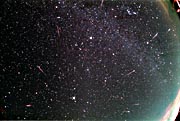 Nov 18 2001, from 26:50 to 27:00 JST(+0900), composed 10shots with 10min. Exp.
Nov 18 2001, from 26:50 to 27:00 JST(+0900), composed 10shots with 10min. Exp.Optical: MD Fish-eye f=16mm F2.8, Aperture: F2.8
Auto-guided with TAKAHASHI EM-200 Equatorial
Camera: MINOLTA SRT-101
Film: Fujicolor SPERIA 1600, Location: Ooizumi vil., Yamanashi pref.
This is a composed image of plural shots taken for about an hour, a cross mark in lower part of picture is equivalent to the radiant point of Leonids positioned in the Lion's sickle. This image shows you many bright meteors are appearing in whole of winter skies.
Around radiant point
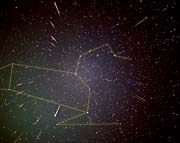
Nov 18 2001, from 25:50 to 28:20 JST(+0900), composed 16shots with 10min. Exp.
Optical:: SMC TAKUMAR f=105mm F2.4, Aperture: F2.4
Auto-guided with TAKAHASHI EM-200 Equatorial
Camera: PENTAX 67
Film: Ektachrome E100S (+3EV pushed), Location: Ooizumi vil., Yamanashi pref.
The Leonid meteors around the constellation of Leo. Many meteors can be seen appeared from a radiant point of Leonids positoned in center of image.
Around winter's triangle
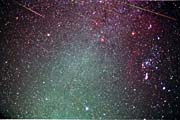
Nov 18 2001, from 25:10 to 26:10 JST(+0900), composed 5shots with 10min. Exp.
Optical: MD Rokkor f=35mm F1.8, Aperture: F1.8
Auto-guided with TAKAHASHI EM-200 Equatorial
Camera: MINOLTA XD
Film: Fujicolor Super G Ace 800, Location: Ooizumi vil., Yamanashi pref.
This image shows you Leonid meteors crossing the winter Milky Way. This field is fairly apart from the radiant point of Leonid, most meteors have long path.
Meteor Storm attacking Big Dipper(1)
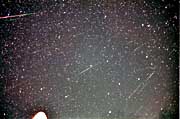
Nov 18 2001, from 26:30 to 27:10 JST(+0900), composed 5shots with 10min. Exp.
Optical: MD Rokkor f=35mm F1.8, Aperture: F1.8
Auto-guided with TAKAHASHI EM-200 Equatorial
Camera: MINOLTA XD
Film: Fujicolor Super G Ace 800, Location: Ooizumi vil., Yamanashi pref.
This wide field picture shows you over 20 meteors flying from upper right to lower left. At that time the Leonids activity had its peak. We couldn't count the number of meteors at all.
Meteor Storm attacking Big Dipper(2)
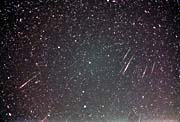
Nov 18 2001, from 27:20 to 28:40 JST(+0900), composed 7shots with 10min. Exp.
Optical: MD Rokkor f=35mm F1.8, Aperture: F1.8
Auto-guided with TAKAHASHI EM-200 Equatorial
Camera: MINOLTA XD
Film: Fujicolor Super G Ace 800, Location: Ooizumi vil., Yamanashi pref.
In close to dawn, the radiant point has been risen and number of meteors was increasing fast. Four bright meteors on the right hand side appeared almost simultaneously. It's considered the local meteoric burst.
A Leonid Bolide with -8th magnitude
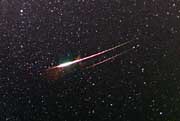
Nov 18 2001, 25:40 JST(+0900), 11min. Exp.
Optical: MD Fish-eye f=16mm F2.8, Aperture: F2.8
Auto-guided with TAKAHASHI EM-200 Equatorial
Camera: MINOLTA SRT-101
Film: Fujicolor SPERIA 1600, Location: Ooizumi vil., Yamanashi pref.
I also could observe many bolides and fine meteoric trains in this Leonids activity. Among them the one of brightest bolides appeared in 1:47 a.m. around eastern region of the constellation of Ursa Major. You can see another normal meteor just below the bolide. This image has been captured with fish eye photo lens, the course of meteors are curved.
Apparent alteration of meteoric train of a Leonids Bolide
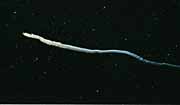 Nov 18 2001, from 25:47:40 to 25:50:38 JST(+0900), continuous photographing
Nov 18 2001, from 25:47:40 to 25:50:38 JST(+0900), continuous photographingOptical: TAMURON SP f=180mm F2.5, Aperture: F2.5
Fixed on tripod
Camera: VIXEN VX-1
Film: Fujicolor SPERIA 1600, Location: Ooizumi vil., Yamanashi pref.
This is a set of continuous 14 images of the meteoric train remained by a bolide captured in upper photograph. The image shows you that the meteoric train has two main streams and each one has fine spiral structures, and changes its shape dramatically flowed by the wind of high altitude atmosphere. It's very interesting that a small-scaled constriction on right hand side is twisting in spiral shape.
Animation GIF(281KB)
Other Meteoric trains of Leonids
# Time Position Mag. # of images 1 25:16 Hya -3 5 2 25:36 CMa -3 or -4 4 3 27:03 Leo -4 4 4 27:25 UMa -4 or -5 5 5 27:26:10 UMa -5 4 6 28:04 Ori -3 3 7 28:06 CMa -3 or -4 3 8 28:27 Mon -3 3 (Common Photography Condition)
Optical: TAMURON SP f=180mm F2.5, Aperture: F2.5
Fixed on tripod
Camera: VIXEN VX-1
Film: Fujicolor SPERIA 1600, Location: Ooizumi vil., Yamanashi pref.
This is an image archive of bolides brighter than -3th magnitude and alteration of remained meteoric trains.
